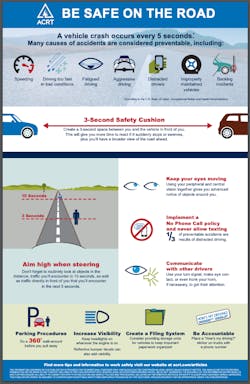Safety Spotlight: Avoid Distractions While Driving
Driving is a routine task that many take for granted. Yet traffic incidents remain a leading cause of work-related death and injury in the United States, with an annual average of 33,000 fatalities during the last five years according to the National Highway Traffic Safety Administration (NHTSA).
The dark cloud: Many of these incidents occur during the workday or commutes. Utilities and their contractors must act now to protect their number 1 asset—employees.
The silver lining: Most incidents are preventable. By promoting safer behaviors, companies can ensure team members make it home to their families each night.
A Prevention State of Mind
While the NHTSA reports that the number of roadway fatalities has decreased by 25% over the past decade, we cannot ignore that most vehicle incidents are preventable.
The National Safety Council (NSC) defines a preventable vehicle incident as the driver failing to do everything reasonable to avoid the incident, which includes committing errors or failing to react correctly in time to the errors of others. Behaviors that lead to such incidents include:
- Speeding
- Unsafe driving in poor conditions (fog, ice, snow, heavy rain, etc.)
- Fatigued driving
- Aggressive driving
- Improperly maintained vehicles
- Neglecting to ensure space is clear before moving, especially when backing up
- Distracted driving
Crashes due to distractions, or those in which drivers lost focus on the safe control of their vehicles due to manual, visual or cognitive distraction, cause at least 3,000 deaths each year according to the NHTSA. Such behaviors include using a cell phone or navigation system, eating, drinking and adjusting a radio.
Studies show that texting involves simultaneous manual, visual and mental interferences and is among the worst of all driver distractions. Observational surveys show that 9% of drivers are texting at any given moment. According to the NSC, your brain is distracted for 27 seconds after a call or text. Sending or receiving a text takes a driver’s eyes from the road for an average of 4.6 seconds. At 55 mph a vehicle travels the length of a football field in that time.
There are ways to help your employees avoid these behaviors—and avoid preventable incidents.
Set Up a Program, Enact a Policy
According to a recent Virginia Tech Transportation Institute study, engaging in visual-manual subtasks (such as reaching for a phone, dialing and texting) associated with phones and other portable devices increased the risk of getting into a crash by three times.
Utilities and other companies can help reduce the number of such traffic crashes and subsequent injuries that impact their workforces and their families. By sharing safe driving tips and educating workers, U.S. employers can directly reach more than half of the driving population—even more when information is extended to employees’ family and community members, according to the Network of Employers for Traffic Safety (NETS).
Communicating simple, actionable steps is key in helping employees remained focused on the task of driving. Companies can tap into several resources such as NETS, the NSC and the Occupational Safety and Health Administration, which provide toolkits for launching a safety campaign at work. OSHA’s “Guidelines for Employers to Reduce Motor Vehicle Crashes,” available online, provides tips and a worksheet that can help calculate how much motor vehicle crashes cost your organization.
Going a step further, developing or expanding a fleet safety program that includes zero-tolerance on distracted driving can help prevent injuries and save lives. To make an impact, collect pledge forms from employees or enact enforceable policies to combat distracted driving.
Fleet safety programs should be communicated through all available channels, including newsletters, vehicle magnets and team meetings. Training should also be mandatory and recurring, not just when an employee starts but as part of any ongoing training program offered by the company.
About the Author
Keith Pancake
Keith Pancake is a safety manager serving ACRT and Bermex. He has been involved in the UVM industry for over 10 years. He is an ISA Certified Arborist and Utility Specialist, an NSC certified Defensive Driving Instructor, and the 2018 Utility Arborist Association’s Silver Shield recipient.

